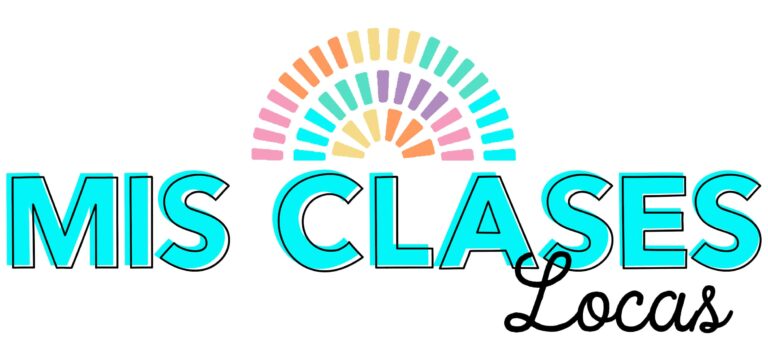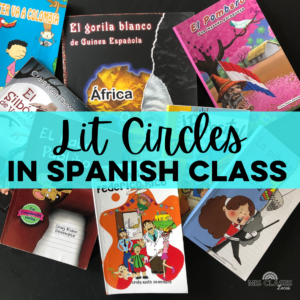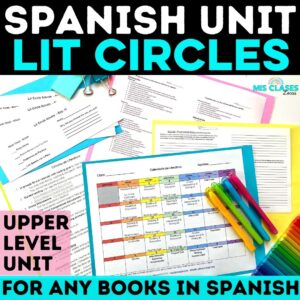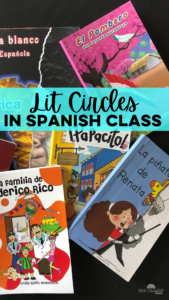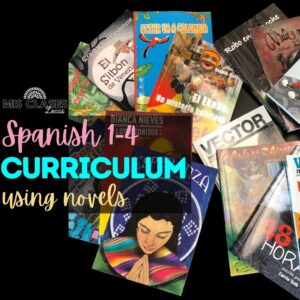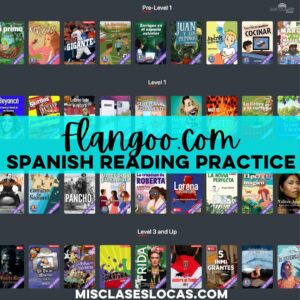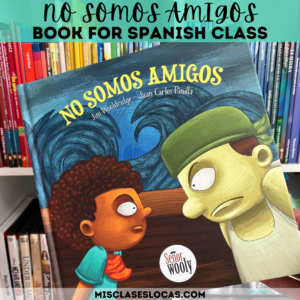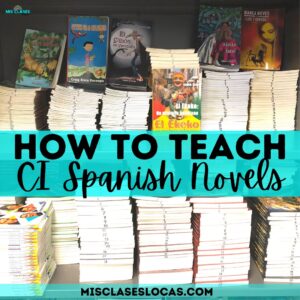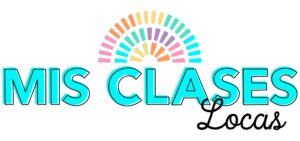What are Literature Circles & how to use Lit Circles in High School Spanish?
Have you wondered how to do literature circles in the classroom in Spanish? Literature circles in my upper level, high school Spanish class means multiple groups of 3-5 students reading and discussing different books all at once. I learned about lit circles from English teachers and my own experience in elementary school. Lit circles are a way to differentiate reading to meet the needs of all students. Ideally, students get a say in which book group they are in during lit circles. Also, a variety of literature circle jobs increases student engagement and buy-in.
How I get started with Lit Circles in the classroom in Spanish
In an older blog post about my Curriculum planning for upper-level Spanish, I mentioned a plan to have literature circles in both Spanish III and IV. I had tried out Literature Conversation Circles with Cajas de Cartón the previous year.
I had always wanted to try out this English class technique, where multiple groups are reading and discussing different books all at once. Luckily, I was a part of the language PLC with the English teachers. A young rock star English teacher shared her wisdom and resources with me while I planned my first lit circle unit. When I first published this post, we had just finished up my first-ever set of literature circles in Spanish 4, and were starting in Spanish 3. *Since then I have done lit circles in Spanish 3 and 4 every single Spring. So, I have taught this unit about a dozen times now, refining it each year.
How to prepare for Lit Circles in Spanish class
For some background, the first time I did literature circles, was my first year at a new school. I had students who had been taught predominantly with a textbook. We read a book each trimester as a class, as well as did free reading. So, these students had had some experience with me reading a book in Spanish, as well as doing activities related to that reader before starting literature circles in the classroom in Spanish.
The first step was to purchase a variety of books in Spanish in sets of about 5. I was lucky that in my first year at a new school, I was able to order books to try out lit circles. I chose the books below, all from Fluency Matters. For Spanish 4, I picked all “level 3 books.’ For Spanish 3 I picked a variety of levels that all use the past tense. This way I could differentiate with a variety of levels of books all in the same class, at the same time. I like that for individual reading, these readers all have a glossary that included every word and cognate.
Pick books to use for Spanish Lit Circles
Spanish 4 – Literature Circles with the following 3 books
- La hija del Sastre
- La Guerra Sucia
- Vida y muerte en la Mara Salvatrucha
Spanish 3 – Literature Circles with the following 4 books in the past tense
- Bianca Nieves y los 7 torritos
- Frida Kahlo
- Los Bakers van a Peru
- Problemas en Paraíso
*Please know these books were ordered in 2016. So there are many more diverse books now from a variety of publishers that you could use for lit circles.* Also, La Guerra Sucia was way too hard for lit circles for a class that this was their first year reading novels in Spanish. The next year I switched out that book for Todo lo que brilla. In later years books changed depending on what we did as a class and the new releases that I was able to purchase. (You can see what I picked in (Curriculum for Spanish 1-4). As with anything that is more independently based, easier is better. You want students to feel confident reading in groups, not overwhelmingly frustrated.
I also suggest having a copy of an audiobook for each group to have as an option as well. I have had a few groups or individuals over the years that like to read along with listening to the native speaker read. This is another good accommodation to meet all students.
Students rank books to read in Lit Circles
I let students rank their choices. To give them more info on each choice, I made a Google Slideshow for each class with a description of each book. These included the country of setting and main cultural themes. Students filled out a form ranking their choices, and giving their reasoning as well. I went through their requests and tried to put students into groups of their 1st or 2nd choice. A the same time, make sure that each group would be a positive functioning unit. For the duration of this unit, groups sat together in table groupings.
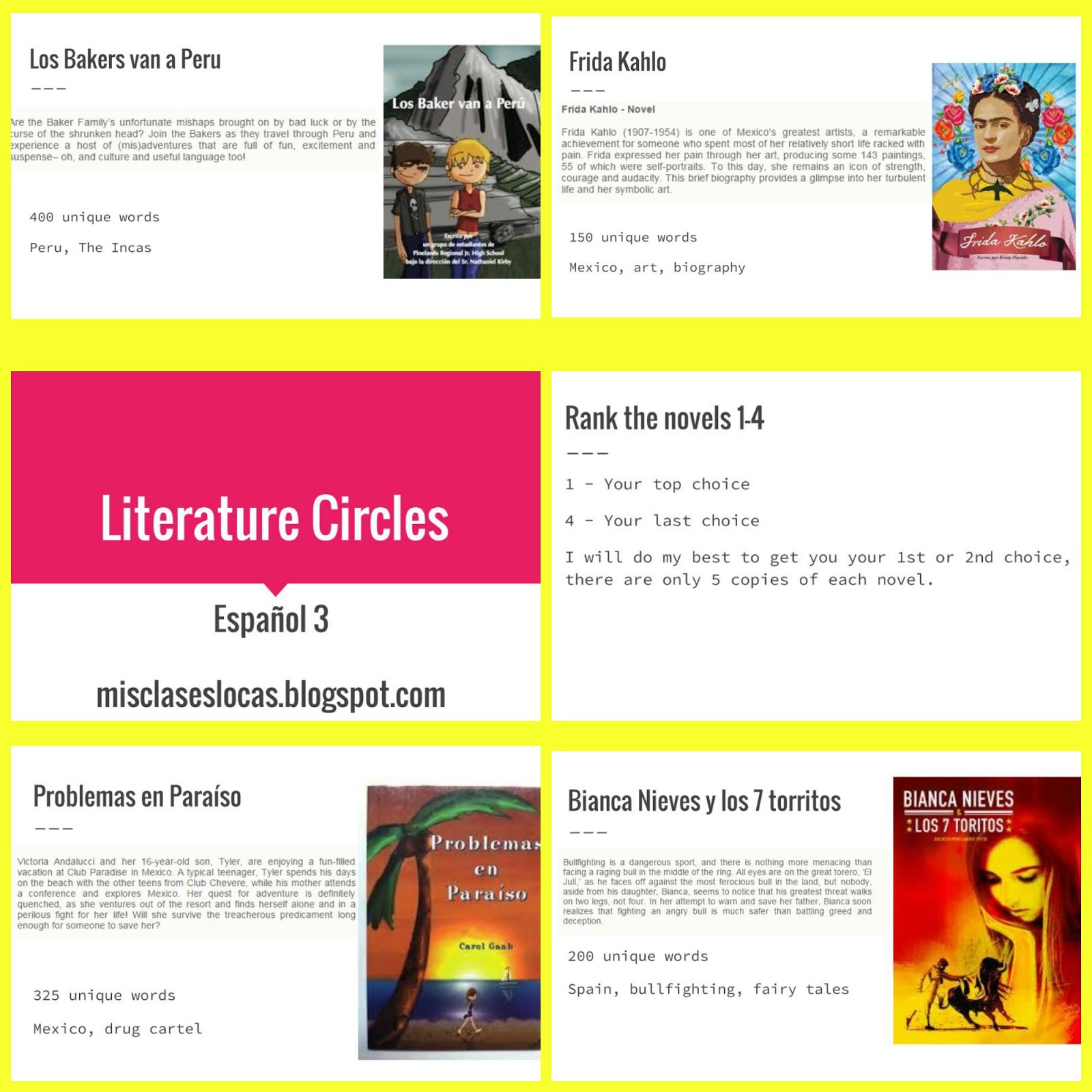
Students Plan for Lit Circles
One of the best parts about the literature circle unit with upper-level high school students is it is a pretty student-centered and led unit. This is why I always did the unit second semester. Students had a chance to experience reading a novel as a class. Also, they knew each other and developed leadership skills and confidence in Spanish.
Once in their groups, students worked together to fill out calendars to keep everyone accountable for their plan for reading days of the literary circles in the classroom. I included an editable calendar like the one below in my ready to go Lit Circle unit from my site or unit on TPT
I suggest as a teacher you first add in the general date. These would be things like no school, early out, as well as when speaking and writing checkpoints and assessments will be. This way, students can decide how they want to space their reading out. They can compare with their sports, or music schedule too. So, they can decide when they want to do heavy reading, or when they as a group want to take it a little easier. While I would check in to see how groups were doing, I ran this unit more like a college class, where it is mostly on the students.
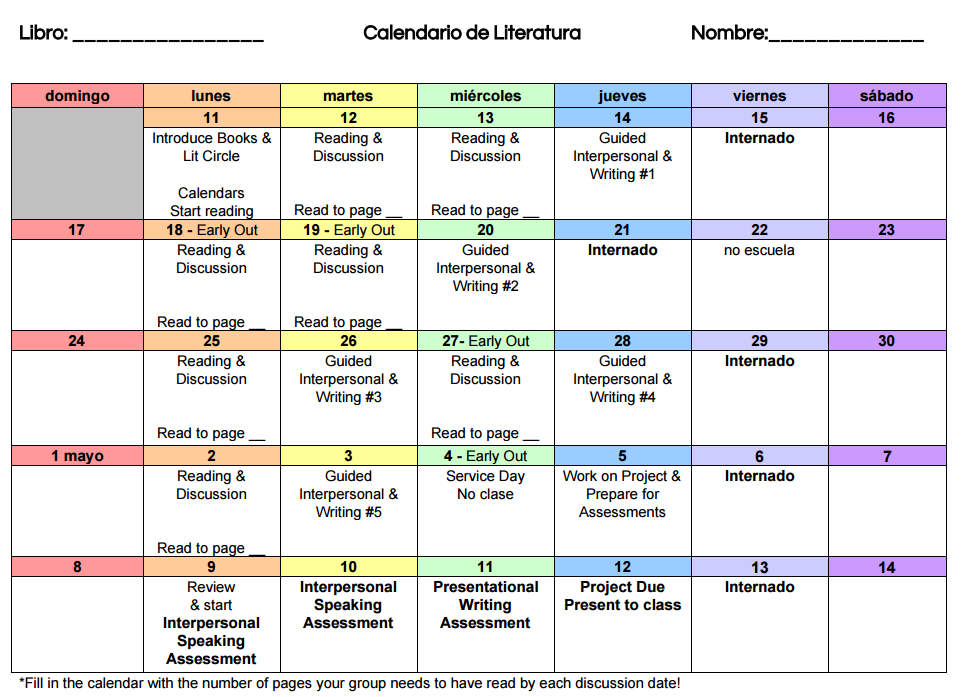
Student Jobs for Literature Circles
Since I have always run this lit circle unit like a college class, in my unit I have not been big into assigning literature circle jobs. I know that for elementary and middle school having set lit circle jobs like the reader, timekeeper, note-taker, etc, can be helpful. But, with a high school junior and senior-led class in the Spring, I let groups naturally pick and choose who does what each day. Here are examples of different lit circle jobs based on the group.
- Group A – One dramatic student with a wonderful accent who likes reading out loud reads to the group each day. In that same group, another student pauses to ask questions, and another takes notes.
- Group B – Independent students might all read silently on their own. In group B they all take notes and then come together to discuss and chat.
- Group C – A group that wants and needs more support might want the teacher there as they read new sections for clarification and support.
I have found by Spanish 4 especially many students fall into their natural group roles. Trying to control them will only lead to animosity. If a group does not seem to be working, I might suggest setting more specific lit circle roles if needed.
Literature Circle Unit Plan in Spanish class
The calendar that was shared with students as the basis of our unit includes the following days as a part of our plan.
Reading & Discussion Days
These are basically open work days with the expectation that groups are working in Spanish on their book. Each group plans and structures these differently. They all have a list of general discussion questions in Spanish for any novel, which helps them when they get stuck. I move from group to group, helping where needed. I wanted to give them enough in-class time to make sure everyone reads, and to provide support for those who like to read out loud with their group. If they finish early, they should prep for the next speaking and writing. See above for my thoughts on lit circle jobs or roles in the groups.
Guided Interpersonal Speaking
Every few days we had a more structured interpersonal time which required us to be completely in Spanish. I give a topic (characters, setting, theme, plot, dram, critique, etc), set a timer for 10-15 minutes, and then walk around informatively assessing. I have a Slideshow with timers, topics & prompts in my unit. It is meant to be like a casual book club and students may use their books and notes.
We usually start in their set books to discuss. Then we sometimes each group numbers off, and one person from each book forms new chat circles. This gives them a chance to chat with someone new and actually ask questions about a book they do not know about. It also ensures that each person in the group is an expert on their book. To support all students, you could use questions cards if needed. *This is often where the real magic of lit circle happens*
Guided Writing
Right after speaking, I set another 15-minute timer and students write about the topic they just discussed, also comparing it to other books and movies. They should give both what they think, as well as what other people said. I usually read these, give feedback and return them as formative practice. Or the next day we might start with students reading their writing, or the writing of someone else and giving feedback. You can get all of the writing prompt forms in the unit plan.
Interpersonal Speaking Assessment
I listen to each group separately as they discuss and critique their book. For an accommodation, use questions cards if needed.
Presentational Writing Assessment
Students write an individual essay in class on paper about their book. They use the literary elements discussed in class, as well as compare them to other books and/or shows/films. (In our class at the time we watched El Internado, you could change to something you watch instead).
Project (optional)
In my first year, each group did a short presentation to teach the others about their book and the related culture. All others were encouraged to ask questions as well. *I later got rid of the project, since it seemed too much to have three summative assessments at the end. Depending on your grade book and what you want to assess, you could just pick two in total. For example, one year we did a project instead of writing, per the request of the students.
Resources for Literature Circles in Spanish class
If you do not want to start from scratch, you can download my entire upper-level Literature Circle Unit from my site or get the unit on TPT I have refined this unit over six years of using a lit circle with high school Spanish students. As well as many teachers used this for distance and hybrid learning. The Spanish literature unit now contains the following as discussed above:
- Google Drive Folder with all of the below items in editable Google documents.
- Directions to the teacher for a 3-4 week unit in upper-level Spanish classes
- Sample book choice slideshow & voting forms
- Editable Calendar for students
- Instructions for Students
- Discussion Questions for any book (In Spanish)
- 5 Weekly interpersonal speaking prompts (In Spanish)
- 5 Weekly writing prompts (with writing forms in Spanish)
- Final Writing Assessment (In Spanish)
- Editable Google Unit Slideshow with daily instructions
- Differentiated instruction through both formative and summative interpretive reading, interpersonal speaking, and presentational writing/speaking in Spanish.
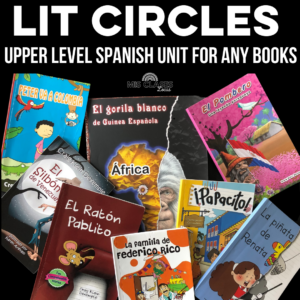
Other Reading Options in Spanish Class
If you do not have multiple copies of each novel and would like to do something similar, try Individual novel study. Check out my posts on how we did Individual Novel Study in Spanish 4 the year before lit circles Individual Novel Study Part 1 & part 2.
If you want to do something similar with novice Spanish students, check out Reading Club – 1 Novel, 3 Groups. Or, I always suggest starting novice students with a full class novel, (How to Teach Your 1st Novel) & FVR.
Overall, I hope that gives you a better idea of what Literature circles are. Also, of how can you use them in upper level, High School Spanish class It has been an excellent way to get upper-level students engaged in my Spanish classes. As always this is a work in progress and I would love any feedback that you have for me to make this better!
Literature Circles in Spanish class was originally published by Allison Wienhold of Mis Clases Locas on April 11, 2016, & most recently updated on March 13, 2023.
